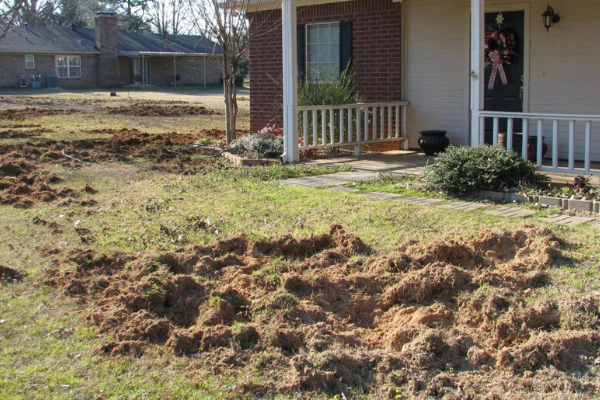Aimed at creating a “feral swine-free zone”
OKLAHOMA CITY – Creation of a “feral swine-free zone” along the Red River is a goal of a three-year pilot project administered by the Oklahoma Conservation Commission (OCC) with a $1.04 million grant from the U.S. Department of Agriculture (USDA).
The Feral Swine Eradication and Control Pilot Program (FSECP) will focus on two areas of the state: Cotton, Tillman, Jackson and Harmon counties in the Western Red River area, and Kay County. The Western Red River watershed is targeted in a multi-state effort of the Oklahoma Conservation Commission and Texas conservation partners in an effort to “significantly reduce the feral swine population where the invasive species has created substantial economic losses,” commission public information officer Bryan Painter wrote in a news release. The goal in Kay County is “to keep the feral swine population in check and reduce the chances of feral swine from migrating into Kansas,” Painter related.
“Oklahoma has struggled with the invasion and exponential growth of feral hogs for years,” said Trey Lam, the OCC’s executive director. “Crops and pastures are being destroyed. Water quality of our streams and lakes is being degraded. Wildlife and its habitat are being destroyed.” Lam said that on his own farm at Pauls Valley, “I lost a stand of corn” to feral hogs in 2014 and again in 2015, and wild pigs caused “fairly significant damage” to his wheat crop “the last couple of years.” “They just wreck the environment,” echoed Scott Alls, state director of the USDA’s Wildlife Services.
STATE, FED AGENCIES JOIN HANDS TO ERADICATE DESTRUCTIVE HOGS
The USDA grant will provide funds and manpower from state and federal partners to target feral swine in specific geographic areas, Lam said. “Our emphasis will be on keeping the eradication locally directed by utilizing local conservation districts working through their cooperating farmers and ranchers,” he said. The FSECP is a joint effort between USDA’s Natural Resources Conservation Service (NRCS) and Animal and Plant Health Inspection Service (APHIS) to address the threat that feral swine pose to agriculture, ecosystems, and animal and human health. The NRCS will “funnel the money” to the OCC, while APHIS “will do the trapping and helicopter work” – aerial shooting of wild hogs – Alls said.
WATER QUALITY MONITORING CRITICAL ELEMENT OF PROJECT
Lisa Knauf Owen, assistant director of the Conservation Commission, provided a closer look at the pilot projects. One of the key components of both projects is the use of pre-and post-water quality monitoring, she said. Using water quality data collected through the OCC Rotating Basin Monitoring Program, the agency will establish a water quality baseline for two small streams in the project areas for comparison with post-implementation water quality data. That information will be used to prioritize additional efforts in areas with the strongest overlap between water quality issues and agricultural damage attributed to feral hogs. These areas will receive more intensive water quality monitoring that will involve more frequent turbidity and bacteria testing, Ms. Owen said. Post-implementation data will be collected in 2023 for comparison to 2019 conditions to evaluate whether water quality has improved as a result of feral swine control, she said.
Wild pigs can have an adverse effect on the quality of water, “whether it’s a pond or lake or a stream,” Lam said. Where feral hogs wallow, “The soil is disturbed, so the soil and any fertilizer applied on it can get washed into a nearby stream or lake.” Feral swine wallows are prime mosquito habitat that contribute to the prevalence of various mosquito-borne diseases, the USDA reports. Wallows can also be a place of transmission for bacteria and parasites from feral swine to native wildlife that come to drink, the USDA says.
CONSERVATION DISTRICTS TO CONTACT LANDOWNERS
Conservation districts will play a major role in contacting landowners to gather damage assessments, schedule access for USDA-APHIS trappers, pre-bait areas for trapping, and monitor trapping sites. Conservation districts also will provide outreach to all county residents as to the need for controlling feral swine populations and educating agricultural producers about programs available to assist with damage repair. The districts will provide landowners with information regarding conservation practices and programs that are available to address resource concerns, Painter wrote.
The OCC and conservation districts will employ and supervise a technician to serve as the local project coordinator. The OCC project coordinator/technician will work side-by-side with USDA-APHIS Wildlife Services personnel and the conservation district staff to deploy feral swine traps to infested areas. The coordinator/technician will be responsible for monitoring and baiting traps, landowner relations, and coordinating with USDA-APHIS Wildlife Services personnel in the affected areas.
‘FIRST STEP IN A LONG BATTLE’
The project is expected to span 36 months, Ms. Owen said. Afterward, it is the OCC’s goal “to have a self-sustaining feral swine control program administered by local conservation districts,” she said. “I know how frustrated our citizens are with the seemingly uncontrollable expansion of feral swine,” Lam said. Feral hogs have been recorded in at least 70 of Oklahoma’s 77 counties. “This pilot project is the first step in a long battle to reduce feral swine damage,” he said. The Oklahoma Conservation Commission, USDA’s NRCS and APHIS Wildlife Services, and local conservation districts “are committed for the long haul,” Lam pledged.




